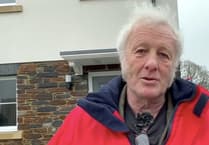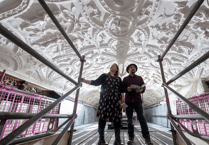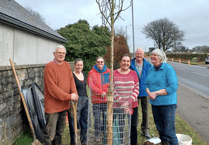A SERIES of events held at St Clether recently gave the public the chance to step back in time to the days of Thomas Hardy and Sabine Baring-Gould to mark their significance to the area.
Barry West, a Cornish historian and researcher from St Austell, hosted his own event over the recent bank holiday weekend, dedicated to the lives of writer Thomas Hardy and the influential Sabine Baring-Gould, who lived at Lewtrenchard Manor.
The event was held at Rosehip Barn in St Clether, as well as the church and holy well, and marked significant moments in the past when Thomas Hardy, the 19th century poet and author of Far From the Madding Crowd, Tess of the d’Urbervilles and The Mayor of Casterbridge, came to Cornwall and met his future wife Emma Gifford.
It is thought that this visit to North Cornwall inspired much of his work thereafter. The event also commemorated a great moment in St Clether’s history, when Sabine Baring-Gould from Lewtrenchard led a procession to re-dedicate the holy well.
On Saturday evening, May 5, over 70 people gathered at Rosehip Barn, to listen to speakers Andrew Leah and Martin Graebe deliver talks on their well-known topics. Barry said: “To be honest, we didn’t expect to get near that amount of people, so it really was a huge success.”
Thomas Hardy was a 30-year-old architect who was tasked with the project of designing and surveying the building for St Juliot Church, St Clether, in March 1870, where he met Emma.
She was living at the rectory with her sister, the Rev Cadell Holder’s second wife, and while in North Cornwall, Thomas visited such places as Tintagel, Beeny Cliff and the Valency Valley — which would be an inspiration for his work for years to come.
He later returned to St Juliot in the summer of 1870, where he and Emma visited Bude, Trebarwith Strand and Strangles beach. Four years later, the pair married, and in 1912, Emma died, leaving Thomas to mourn through his poetry.
Andrew Leah delivered his talk on Thomas Hardy on the Saturday evening, while Martin Graebe presented a talk on Lewtrenchard man, Sabine Baring-Gould, who was involved in the restoration of the well chapel of St Clether in 1898.
Sabine Baring-Gould, born in 1834, wrote many books and articles on Cornwall, as well as taking the county and its people as inspiration for a collection of hymns and songs he wrote during his time. Sabine Baring-Gould is responsible for the well-known hymn ‘Onward Christian Soldiers’, written in 1865.
On Sunday morning, May 6, a recreation dedicated to Thomas Hardy’s journey to St Clether vicarage took place. Actors representing Hardy and Emma Gifford travelled by pony and cart from St Juliot Rectory, as they would have done in 1871, to St Clether vicarage, home of Henry William Sergeant, Hardy’s love rival for Emma.
Bringing the history alive for those in attendance, Barry read Hardy’s famous poem The Face at the Casement to recreate the moment only experienced before by Hardy, where as he and Emma rode away in the cart, he looked back and saw Sergeant’s face at the casement.
At 3pm, after pasties and refreshments, the bells pealed and the procession to the holy well began, marking the moment belonging to Sabine Baring-Gould.
In 1899, following the restoration of the chapel at St Clether, Sabine Baring-Gould led the re-dedication of the nearby holy well, where a baby of a poor couple was christened unexpectedly. This event is something that Barry was keen to recreate during the Sunday of the bank holiday weekend, and with the sun beaming down on those wanting to relive the moment, it was an extraordinary day.
Kindly provided by Barry, the Post has gained an insight from a local newspaper report detailing the event in 1899. Described as a day of ‘exceptional brilliancy’, nearly the entire neighbourhood was present, ‘grouped on the spires of rock overhanging the valley’, to watch Sabine Baring-Gould re-dedicate the holy well.
The congregation began the service by processing from the church, headed by a cross, with the hymn ‘O word of God above’ sang leaving the church and then hearing the 68th Psalm ‘Exurgat Deus’ as they reached the chapel.
Along with members of the community, the congregation reportedly included masons, carpenters and workmen who had been involved in the restoration work, churchwardens and principal benefactors, the Sunday schoolchildren of St Clether, the choir of Lewtrenchard, the ‘boys and men in cassocks and surplices’ and the clergy.
As the congregation reached the west door, a prayer was said and the choir and clergy entered the building where prayer was offered and Psalms sung. After that, the procession left by the north door and went around the chapel singing the hymn ‘Blessed city, heavenly Salem’. As the procession reached the outer well, prayer was made and ‘A living stream as crystal clear’ was sung, followed by a brief address delivered by Sabine Baring-Gould on the life of Saint Clether and the restoration of the chapel.
The report reads: “At this moment, an unexpected incident occurred. A couple of poor parents arrived with their babe, and begged to have it christened then and there at the holy well. This accordingly was done, and the child received the Christian name of ‘Clether’. The procession then left singing the Nunc Dimitis.”
This procession was duly recreated by Barry and those who attended the events at St Clether over the bank holiday weekend, where Barry’s grandaughter Lyla Rae was christened at the holy well, believed to be the first child to be christened at this site since the very day that took place in 1899, where a baby boy from the local area was christened unexpectedly by the Rev Baring-Gould.
Barry led the procession carrying a wooden cross, whilst those taking part in the procession carried colourful banners, along with people who had worked on the well to maintain it and ensure its future, just as workers did in 1899. At the end of the day, those in attendance were treated to some music and singing from the Altarnun Community Choir, with songs of praise ending with Now the Day is Over by Sabine Baring-Gould.
To Barry’s surprise, he was delighted when he met three people who had come along to the event especially to commemorate their relative. Ivor Allin, Winifred Robbins and Phyllis Sleeman from the Launceston area are directly related to the baby christened by Sabine Baring-Gould at the holy well in 1899, who was named Thomas Henry Cleather Allin.
Eldest son of Samuel and Annie Kate Allin, Thomas, known to many as ‘Cleather’, would go on to have four younger siblings — Stephanie Lucinder, Winifred’s mother; Samuel John, known as ‘Jack’, Ivor’s father; Elsie Ruth and Leonard Theodore. This means that baby Cleather is the uncle of Ivor and Winifred, and a distant cousin to Phyllis, whose grandfather Harry was brother to Cleather’s father Samuel.
Barry said: “Sabine Baring-Gould re-dedicated the holy well at St Clether. There was a child christened ‘Cleather’ by him. It’s an amazing story and one that deserves to be shared.
“We recreated the whole event as accurately as we could. My granddaughter, we believe, is the first child to be christened there since that date.”
Lyla Rae, who is four-years-old in September, was christened at the holy well on the Sunday, with the Methodist minister Doreen Sparey-Delacassa leading the service.
Along with the events held over the bank holiday weekend, St Clether Church also held their own flower festival, meaning the church was beautifully decorated for visitors.
The event raised over £1,000, which is hoped to be put towards a memorial to Thomas Hardy and Sabine Baring-Gould at St Clether, with some of the money raised also going towards the upkeep of the holy well.
Barry added: “I’d like to say thank you to all the people who helped and supported me with this event.”




